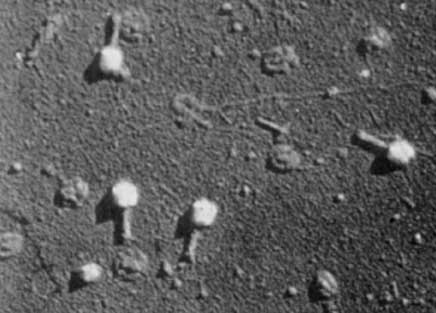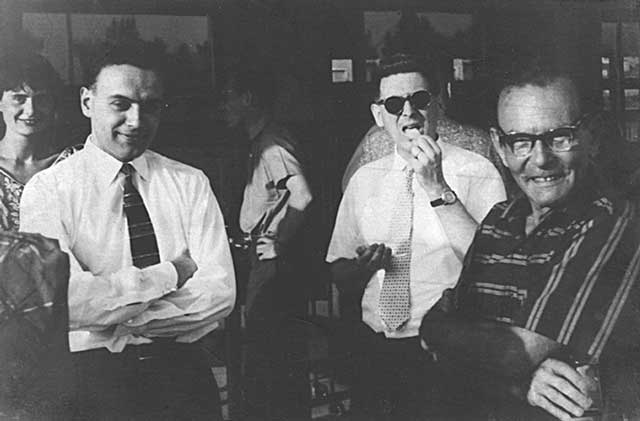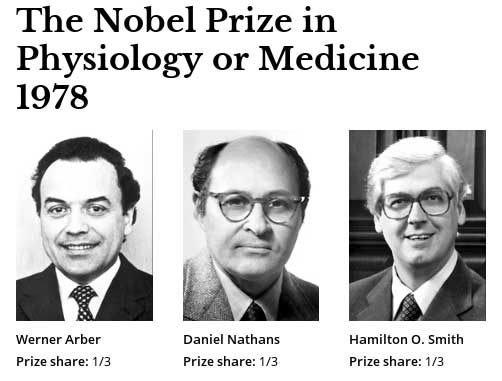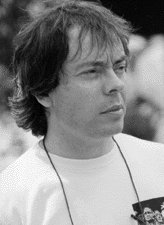History

Molecular biology in Geneva can trace its early roots to the Institute of Physics of the University of Geneva. In 1931, the Swiss experimental physicist Jean Weigle (Tribute) became director of this Institute and, a decade later, started to develop the first electron microscope made in Switzerland. He was helped in his continual efforts to improve the microscope by Edouard Kellenberger (from the ETH; Hall of Fame), also a physicist. In 1948, Jean Weigle, at the age of 47, resigned from the faculty of the University of Geneva and went to Caltech in California to work in the group of Max Delbrück, another physicist who played a key role in the early development of molecular biology. There, he concentrated on the study of the genetics of bacterial viruses (bacteriophages), but still visited his old laboratory in Geneva each summer. The competence of Jean Weigle in physics and his new interest in biology gave him an interdisciplinary advantage in the study of bacteriophages. When he came to visit his former laboratory in Geneva, Weigle brought fresh ideas, mutants, and reagents from Caltech and other leading research centers spreading the rise of bacterial genetics. Edouard Kelleberger shifted his interests from improving instrumentation to the development of new methods, together with Antoinette Ryter, to observe bacteriophages using the electron microscope.

In 1953, Edouard Kellenberger became director of the Biophysics Laboratory where he formed a group of researchers to work on the genetics of bacteriophages and develop new methods to observe them with the electron microscope. This group included Werner Arber (Hall of Fame), who became his first assistant in 1953, Grete Kellenberger-Gujer (Tribute), Janine Séchaud, and Antoinette Ryter, who all worked on the genetics of the bacteriophage T4 and electron miscopscopy.
In the beginning of the 60s, the Biophysics Laboratory expanded by the recruitment of Richard Epstein (UCLA), while Alfred Tissières (Hall of Fame, from Harvard) and Pierre-François Spahr (Harvard) joined a new Biochemical Genetics Laboratory, where they worked on the biosynthesis of proteins and transcription. In 1963, both laboratories became part of a newly created Institute of Molecular Biology, the first in Switzerland. The Institute offered a Certificate of specialization in molecular biology where Ulrich Laemmli (Hall of Fame), Bernard Hirt, and Dimitri Karamata formed the first class.

Edouard Kellenberger clearly had an eye for talent. In 1959, Kellenberger hired Werner Arber, who had just spent a postdoc in the United-States, to become faculty member. Arber stayed until 1970 and during these six years, he worked with his assistant Daisy Dussoux on the mechanism by which bacteria resist infection by bacteriophages. His research led to the discovery of restriction enzymes, which proved essential for the development of molecular biology. For this discovery he was awarded the Nobel Prize in Physiology and Medicine in 1978, together with Hamilton Smith and Daniel Nathans.
Edouard Kellenberger also engaged Jacques Dubochet (Hall of Fame) who had just graduated in physics from the École Polytechnique de l’Université de Lausanne (now EPFL) as a student in his laboratory. Dubochet received his Certificate of specialization in molecular biology in 1969 and worked towards his PhD under Kellenberger. After his defending his thesis at the University of Basle in 1973 Jacques Dubochet went to the European Molecular Biology Laboratory in Heidelberg, where he developed a new technique for freezing biological material, leading to the birth of cryo-electron microscopy. He was then appointed professor at the University of Lausanne where he continued to improve microscopy techniques to visualize biological structures. These efforts were rewarded by the Nobel Prize in Chemistry together with Joachim Frank and Richard Henderson in 2017. Sadly, Edouard Kellenberger passed away in 2004 (Obituary) and thus could not celebrate the second time one of his mentees (after Werner Arber) received this distinction.
In 1969, Edouard Kellenberger and Werner Arber went to Basel to create a new research center, the Biozentrum. In Geneva, the Department of Molecular Biology was created from the Institute of Molecular Biology and in 1970 it moved to a new building (Sciences II). In 1971, Lucien Caro (from the Rockefeller Institute), Harvey Eisen (from UCSF), Jeffrey Miller (from CSH) and Roger Weil (from UNIL) joined Alfred Tissières, Pierre-François Spahr and Richard Epstein. Throughout the following years, new professors joined the Department: Bernard Allet, Erich Nigg, Susan Gasser, Ulrich Laemmli (Hall of Fame, honorary professor), Jean-David Rochaix, Ueli Schibler (Hall of Fame, retired), David Shore, Robbie Loewith, Thanos Halazonetis, Thomas Schalch, Florian Steiner, Ramesh Pillai and Andreas Boland. In 2003, the Department moved again to a new building, Sciences III, to join the other Departments of the Section of Biology. As of 2022, the Department meerged with the Department of Cell Biology and has been renamed the Department of Molecular and Cell Biology, hosting 11 research groups (see Research Groups).
(On the early history of molecular biology in Geneva, see Strasser 2006)
The BICEL history
The "Département de Biologie Cellulaire" (BICEL) was created in the late 80s by a decision of the University authorities. The aim was to equilibrate the budgets and numbers of group leaders of the four preexisting biology departments by transferring resources into a new department. The blueprint for this bold restructuring was the report of 1986 by Prof. Bernard Fulpius from the Section of Chemistry. He had been commissioned by a vote of the professors of the Faculty of Science in January 1986. Hence, BICEL was created, initially with three professorships, from existing resources drawn from three (of four) of the preexisting departments. The plan was to recruit two senior scientists as full professors and one junior scientist as associate professor (the University did not have assistant professorships back then). By 1990, three candidates had been selected. One of the two senior ones withdrew still early in the process. The appointments of the other two candidates were officially confirmed by the cantonal government (the nominating body at the time).
By the summer of 1990, it became clear that the second senior appointee, and potentially the future chair of the new department, was not going to join the University of Geneva. Moreover, because of a legal quirk, the junior recruit Dr. Didier Picard, postdoc at the University of California at San Francisco (UCSF), was appointed as full professor. As planned, the first part of the resources and personnel were transferred to the new department. Among the latter, there was the senior lecturer (MER) Dr. Georges Spohr, who ran his own independent group working on bHLH transcription factors in Xenopus development until his retirement in 2004.
This is why BICEL officially started with Dr. Didier Picard as the first (and only) professor and with Dr. Spohr on July 1, 1990, on the 1st and 2nd floors of the newly opened first part of the building Sciences III. While Prof. Picard launched his own group to work on steroid receptors and the molecular chaperone Hsp90, he became BICEL chair, by default. Everything in the fledgling department with empty rooms had to be set up, furniture and equipment ordered, procedures worked out, and, above all, the recruitment process for the two vacant professorships restarted. This time it worked and Dr. Thomas Kreis from the EMBL (working on membrane traffic), and Dr. Angela Kraemer from the Biozentrum in Basel (working on splicing) joined BICEL in 1992. They had been preceded by Dr. Katharina Strub (working on the signal recognition particle-mediated transport of proteins into the endoplasmic reticulum) from UCSF who joined BICEL as an independent group leader in 1991. In 1992, Dr. Strub became a START fellow ("Swiss Talents for Academic Research and Teaching", the "Swiss National Science Foundation" scholarships, which later became the SNSF professorships and then "Eccellenza professorial fellowships"), a senior lecturer in 2000, and professor in 2008. Dr. Karl Matter and his senior research and teaching assistant Dr. Marisu Balda (working on epithelial cell polarity) from Yale joined BICEL, with Dr. Matter as a second START fellow in 1994, until their departure to London in 2000.

The year 1998 left its mark on BICEL because of a tragedy: Prof. Kreis, only a few weeks after he had taken over the BICEL chair, died in the infamous Swissair crash on his way back from the USA. Having made sure that there were solutions for the members of his team, BICEL moved on by appointing Prof. Kraemer as the new chair and by launching a call for the vacant professorship. This is how Dr. Jean-Claude Martinou (working on apoptosis and mitochondrial metabolism) from the Serono Pharmaceutical Research Institute, Geneva, joined as a full professor in 2000. He would eventually take over the BICEL chair a few years later.
In 2003, Dr. Françoise Stutz (working on mRNA export), START fellow at the University of Lausanne, joined as MER and 5th group leader (3 women, 2 men). She was promoted to associate and full professor in 2010 and 2015, respectively. In 2012, BICEL appointed Dr. Sandra Citi (working on tight junctions) from the neighboring "Département de Biologie Moléculaire" (BIMOL) as MER, and in 2015 as associate professor. In the meantime, in 2014, both Prof. Kraemer and Prof. Strub had retired, allowing BICEL to recruit Dr. Paul Guichard (and his co-PI Dr. Virginie Hamel; working on the function and structure of the centrosome) from the EPFL with an SNSF professorship in 2015 (and promotion to associate professor in 2021). The retirements of Prof. Martinou in 2021 and Prof. Picard in 2022 created the opportunity for yet other recruitments, notably Dr. Ivana Gasic (working on the regulation of tubulin expression) from Harvard Medical School in 2021 with an Eccellenza professorial fellowship.
Finally, under the leadership of Prof. Françoise Stutz, who had become BICEL chair some years back, and more recently also chair ad interim of BIMOL, BICEL gracefully disappeared, at the age of 32 years, by fusion with BIMOL to become the new "Département de Biologie Moléculaire et Cellulaire".
Didier Picard, 14.08.2022
